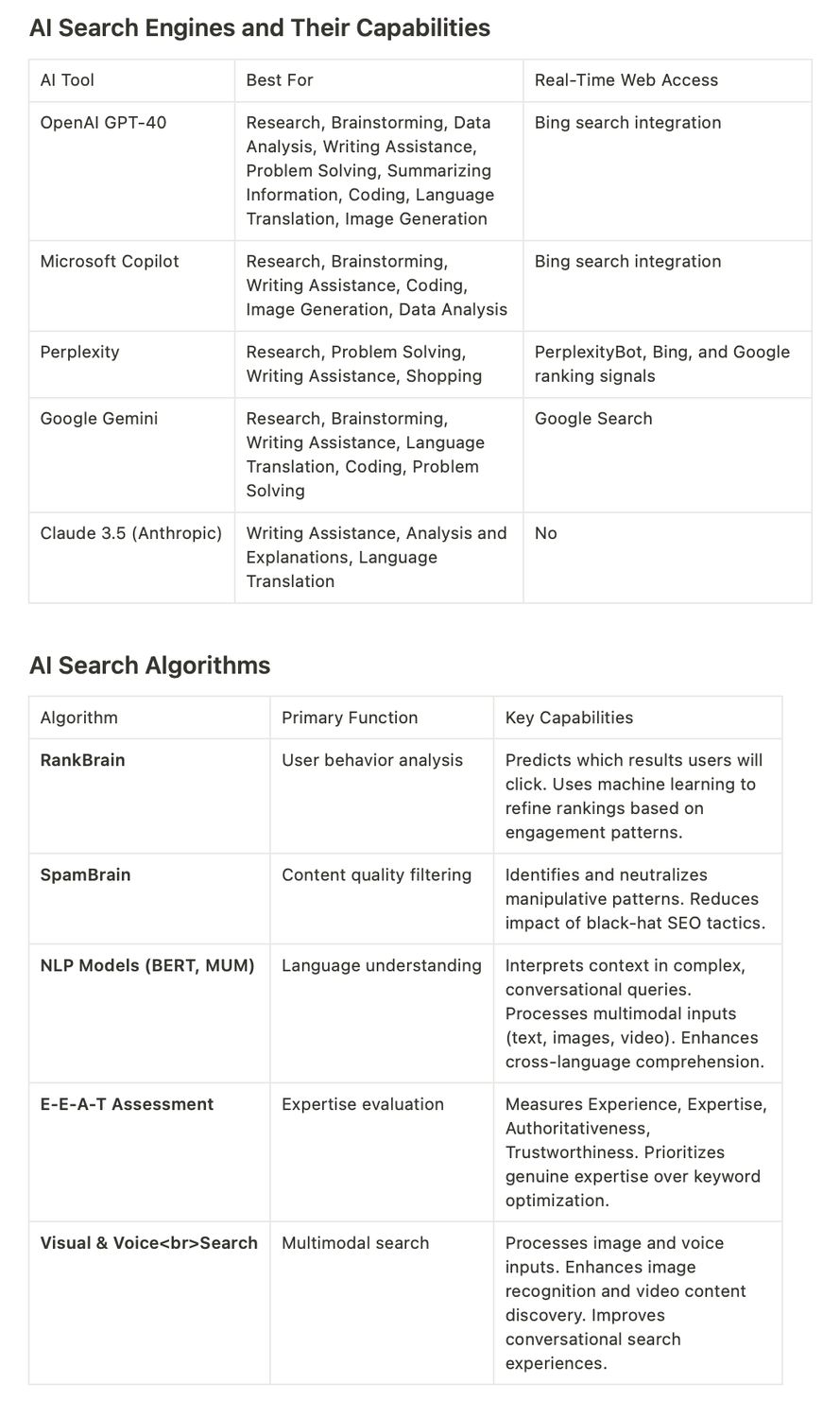The Psychology Driving The Evolution of Search
A Tragicomedy of Marketers Chasing Content While SEO Laughs from the Shadows
Ah, another day, another marketing "expert" declaring SEO dead while hawking their revolutionary replacement — which, upon inspection, is just SEO wearing a mustache and fake glasses. Adorable.
Watching today's marketers fumble with search strategy is like watching someone insist on using a paper map while driving a Maserati fully equipped with AI-assisted GPS. The "create engaging content!" brigade continues their ritualistic rain dances around the content calendar while steadfastly refusing to learn the fundamental cartography of analytics or the strange anthropology of actual user behavior.
Here's the unfiltered truth:
Search isn't dying — it's metastasizing across the digital ecosystem. Your precious channel-specific strategies are quaint artifacts of a bygone era, like flip phones or marketing plans that don't account for TikTok.
In 2025, search isn't a channel, it's the invisible architecture underlying every digital interaction. Your customers don't mentally categorize "searching" versus "browsing" — they're simply following desired paths toward information, wherever it's most accessible.
This behavioral mutation demands strategic adaptation. While marketing departments maintain their neat taxonomies of platforms — Instagram strategy here, SEO strategy there, content calendar in a separate silo entirely — actual human beings flow seamlessly between digital spaces like water finding the path of least resistance.
Your potential customers discover products, services, and content across a fractured landscape of platforms, each with its own behavioral codes and psychological triggers (you see, digital microcultures with their own languages and customs).
This shift isn't merely technical, it's fundamentally psychological. Each platform shapes expectations, trust signals, and discovery behaviors. The psychological dimensions aren't supplementary to optimization; they're the whole point.
How Search Splintered Across Platforms
Search fragmentation isn't random; it follows discernible behavioral patterns. Users don't consciously choose search platforms with strategic intent, they follow the principle of cognitive efficiency, the path requiring the least mental energy (dopamine and doom scroll? Sign me up!).
When Instagram users need visual inspiration, they don't exit, open Google, type a query, and navigate results—they simply tap the search icon already in front of them. The attention economy demands minimal friction.
The numbers reveal the fractured topography of our search landscape:
Source: NP Digital
Modern search systems have evolved beyond mechanical keyword matching into something closer to thought interpretation—they process context, understand multimodal inputs, and prioritize experience signals. The result is a search ecosystem that mirrors human cognition rather than adhering to rigid taxonomies.
How AI Changed Everything
AI content detection algorithms have fundamentally altered the visibility landscape, creating a new psychological contract between creators and search systems. Pure AI-generated content now triggers algorithmic immune responses across platforms, reflecting an ecosystem-wide preference for authentic human expertise.
These algorithms don't simply locate content, they evaluate expertise, authority, intent, and value. They operate across platform boundaries, creating an interconnected discovery ecosystem that rewards authentic expertise over optimization techniques. The algorithms driving discovery have evolved from simple matching systems into sophisticated psychological profiling mechanisms:
Source: NP Digital
The optimal approach combines AI efficiency with human expertise using automation for research, structure, and technical optimization while preserving the irreplaceable elements of human insight, experience, and perspective. This balanced approach mirrors how users intuitively evaluate content authenticity.
Pro Tip: Sit in on a few free AI training sessions from your top LinkedIn AI crush and learn to write advanced prompts. Once you've discovered 10+ hours a week in freed up time, where you can finally launch that YouTube Channel you've been secretly dreaming of. Or...become a better SEO strategist.
Generation Search Gap: Platform Preferences Reshape Discovery
The fragmentation of search follows generational fault lines that reflect core cognitive differences in how age cohorts process information and establish trust.
Younger generations demonstrate pronounced visual processing preferences and rapid context-switching capabilities. This neurological tendency manifests in platform selection: Gen Z conducts 73% of searches on platforms like TikTok, Instagram, and YouTube. Their information processing style prioritizes visual pattern recognition over linear text analysis.
The behavioral implications run deep. Gen Z and Gen Alpha demonstrate significantly lower trust in centralized information sources like Google. Their trust framework depends on peer validation, visual authenticity signals, and creator relatability — factors emphasized in platform-specific algorithms.
This isn't simply about platform preference, it actually reflects fundamental differences in information processing and trust establishment. Older generations follow linear, text-based search patterns with high institutional trust. Younger users employ rapid, multi-platform search strategies with distributed trust networks (which yes, give the older generations, including myself, heart attacks).
Why Images Dominate Discovery
Let's talk about images. I know, it's getting complex, but darlings, this is behavior.
In my humble opinion, visual search has overtaken text for a neurological reason, because the brain can process an image faster than text. In fact, the human brain processes images as little as 13 milliseconds. This biological reality has reshaped search behavior across platforms.
It's no wonder that short-form video generates the highest engagement, with how-to content and visual demonstrations outperforming text-based alternatives. Visual content reduces cognitive load while increasing information density and emotional resonance. And the data (seen in the chart above) confirms this with YouTube processing 3.3 billion searches, Pinterest handling 2.4 billion searches, and Instagram serving up 6.5 billion searches daily.
For marketers, this demands evolution from keyword optimization to visual search optimization. Image alt text, video transcripts, and visual content structure now directly impact cross-platform visibility. The principle of pattern recognition drives this evolution, with users developing platform-specific visual search behaviors.
E-E-A-T and The Psychology of Trust Signals
Trust establishment has become platform-specific and psychologically nuanced. The E-E-A-T framework (Experience, Expertise, Authoritativeness, Trustworthiness) now extends beyond Google to influence visibility across all search platforms.
Each platform emphasizes different trust elements:
Google prioritizes detailed content and in-depth knowledge,
Instagram emphasizes personal stories and brand authenticity,
TikTok weights creator authenticity and relatability,
Amazon prioritizes review consistency and specificity,
Google users demonstrate higher tolerance for institutional expertise signals.
Social platform users exhibit stronger response to experiential and peer-validated expertise. E-commerce searchers display heightened sensitivity to social proof indicators. The common thread here is that users aren't searching for content, they're searching for trustworthy solutions to specific problems. Understanding the mechanisms behind platform-specific trust establishment is now essential for search visibility.
New Success Metrics That Matter
Traditional SEO metrics provide an increasingly incomplete picture of search success. The reality of platform-specific engagement demands new measurement approaches. For example:
Visibility metrics must now span platforms: featured snippets, knowledge panels, AI tool citations, and platform-specific visibility indicators. These signals reflect algorithmic evaluation of content value across the search ecosystem.
Engagement metrics reveal how users interact with content: time on page, social sharing patterns, comment engagement, and content completion rates. These indicators measure resonance more effectively than simple traffic metrics.
Conversion metrics connect search visibility to business outcomes: content-driven lead generation, multi-touch attribution, and cross-platform conversion paths. These measurements reveal the journey from discovery to decision.
This metrics evolution reflects the complex reality of modern search behavior. Users no longer follow linear paths from query to conversion. They navigate complex, multi-platform discovery journeys with platform switching based on information needs and contextual preferences.
Adapt or Disappear
We Used to Say The Best Place to Hide a Dead Body was on Page #2 of Google, Page #2 is dying too
Your audience isn't waiting for your digital transformation roadmap to be approved—they've already scattered like mercury across the fractured glass of platform ecosystems. While you're debugging your Google Search Console, your customers are having fever dreams in TikTok rabbit holes and Instagram discovery vortexes. The data screams a simple truth: search isn't dead—it's everywhere at once, paradoxically both more powerful and less containable than ever before.
Notes: Claude and I have a love affair. He lovingly helps me organize and polish these articles so that they’re way more readable than they start out with. Also, I’ve done my best to cite my sources for the tactical stats and information, but after 30 hours of research, I may have missed a few. That’s okay, Search God, aka Neil Patel, has most of it on his YouTube channel.



